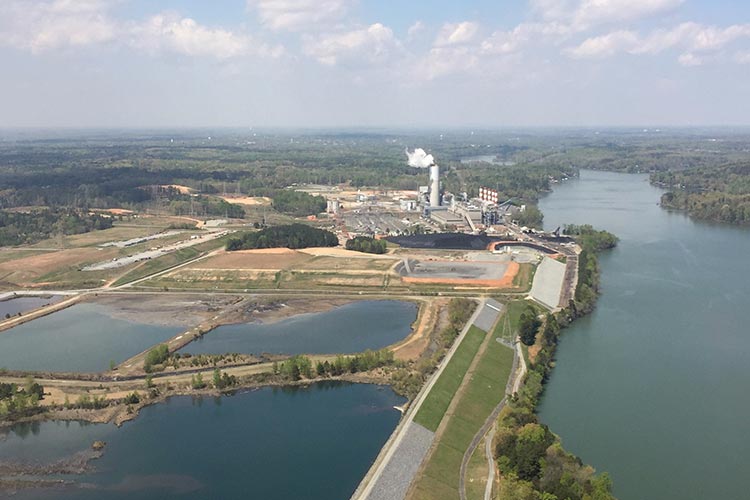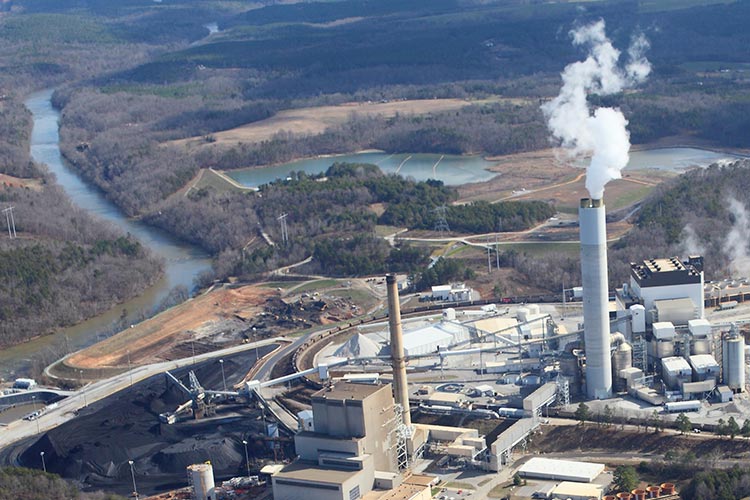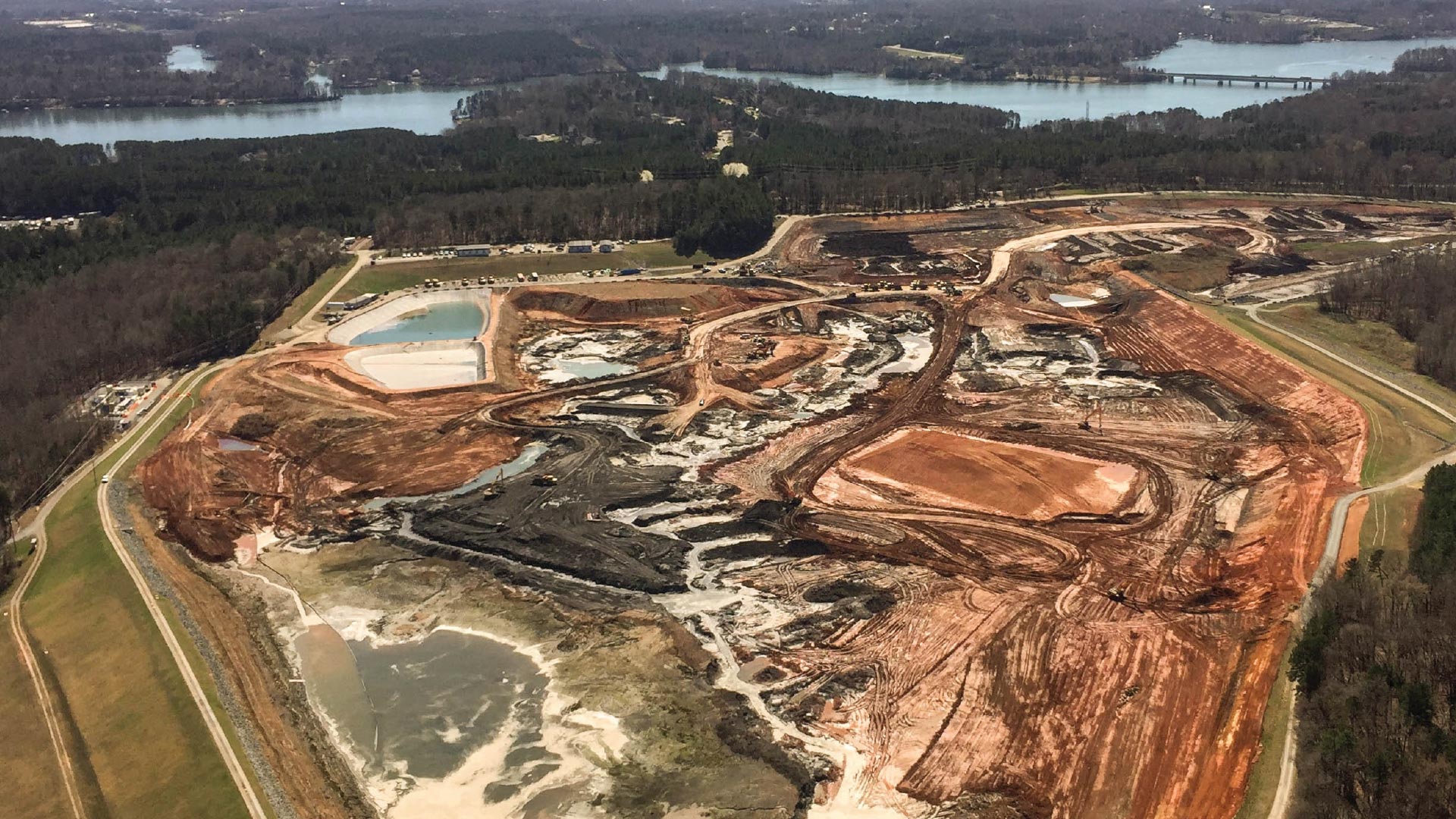LouAnn Watkins just wants drinking water without cancer-causing toxins. A 2016 test of her home’s well water found levels of a potent carcinogen, hexavalent chromium, more than four times the level that had recently prompted “do not drink” warnings from the state.
The culprit? Watkins and other residents suspect the network of ash ponds at Duke’s Rogers Energy Complex in Mooresboro, N.C. State law only requires utilities to provide clean water to residents living within a half-mile of such ponds, a limit that geologists say has no scientific basis. Watkins lived just a few hundred yards beyond that limit.
She worries about the long-term health impacts of this water on her and the five-year-old niece and twin grandchildren she has helped raise. Partly because of this concern, she abandoned her since-repossessed manufactured home to move across the road into her mother’s house.
A test of LouAnn Watkins’ well water found levels of a potent cancer-causing agent more than four times the level that had recently prompted “do not drink” warnings from the state.

She watched as the new, Duke-financed county water line came to an abrupt stop at a bridge running over a creek next to her old lot. She knows this means she can’t get a decent price for the property, which has been in her family for decades, or even pass it on to relatives.
“Nobody could ever stay there with the water that bad,” she said.
All the while, she has not received so much as bottle of water from Duke.
“I haven’t been compensated for one thing,” Watkins, 45, said, looking at her vacant lot from her mother’s porch. “They don’t care anything about us on this side of the bridge.”
Citizens across the South fear that coal ash poisons the water they drink and swim in and the fish they catch. It’s been one of the region’s biggest environmental stories since a collapsed pipe poured thousands of tons of coal ash into the Dan River from a pond at a Duke plant in Eden, N.C. in 2014.
Utilities say it is an old story about a threat that is already being addressed. Duke spokeswoman Erin Culbert, for example, said recently that in spending billions of dollars to clean up or cap old pits, the utility is on “common ground” with environmentalists. The company is complying with a state law that requires it to provide its plants’ neighbors with clean drinking water. It is converting or replacing many of its old pits so they burn natural gas, part of an industry-wide shift that will greatly reduce the estimated 130 million tons of coal ash that utilities create annually. And by the end of the year, she said, all of the ash Duke produces in North Carolina will be either recycled or stored in dry, lined landfills.
But environmentalists say this problem is far from solved.
Thousands of residents, like Watkins, still live with unsafe drinking water. The fix the company plans at six of its sites, called cap-in-place, involves covering ponds with plastic sheeting, but leaving the ash, meaning toxins continue to seep into groundwater. According to data from Duke Energy, groundwater near ponds is fouled with high levels of arsenic, lead, boron, selenium and other contaminants, including radium at concentrations 38 times safe drinking standards at the Duke plant in Asheville.
Instead of protecting residents from these toxins, however, the EPA has been busy rolling back hard-won federal regulations. One of the first actions of Scott Pruitt’s successor, Andrew Wheeler, a former coal lobbyist, has been gutting most of Obama’s coal ash rule. The next phase may include ending the requirement to disclose the results of groundwater testing, which “has been such a crucial step in allowing the public and advocates to understand the full scope of the problem,” said Amy Adams, the North Carolina program director for Appalachian Voices.
The EPA is also handing over regulation of coal ash to states, which means the complex, politically fraught job of regulating coal ash will be left to underfunded state environmental agencies and, ultimately, lawmakers who have proven unable to stand up to corporate powerhouses such as Duke, says Frank Holleman, an attorney with Southern Environmental Law Center.
“The EPA is trying to give these [state] agencies the discretion to let the utilities off the hook.”

What Exactly Is Coal Ash?
Though Duke has sought rate increases to make customers pay for cleaning up ash pits, utilities are clearly to blame for the contamination, Holleman said.
“The utilities voluntarily created an unsafe and irresponsible situation merely for convenience and some marginal cost savings,” he said.
Burning coal distills heavy metals and other non-combustible poisons in the ash. For decades, utilities have mixed this residue into a slurry and pumped it into unlined ponds. Because the plants need large sources of water, these pits are often separated from rivers only by aging, earthen dams. Some of the pits are below the water table, leaking directly into the aquifer. And as modern power plants extract more chemicals such as mercury from their emissions, more of it ends up in coal ash.
“We use 21st-century technology to take toxic substances out of the air, but 19th-century technology to transmit them in concentrated form into water systems,” says Holleman.
The influence of regional utilities, especially Duke and Dominion, can be easily traced in public records and media reports. On the federal level, Duke spent a total of $1.5 million in political donations and $6.4 million on lobbying during the 2016 election cycle, while Dominion spent $1.2 million in contributions and $2.8 million on lobbyists, according to the nonpartisan Center for Responsive Politics. Duke CEO Lynn Good both met with and called the EPA’s Pruitt before he announced plans to relax the regulation of coal ash.
Influence is just as obvious in the weak state controls on utilities, critics say. In 2016, Duke mobilized lobbyists to undermine state coal ash rules. The result was a new coal ash law that would allow some of the coal ash ponds to be capped in place, or, as French Broad Riverkeeper Hartwell Carson describes this process, “pushing the coal ash around a little bit and putting a tarp over it.”

Is our water safe to drink?
For citizens across the Southeast, there is one central question: Is our water safe to drink and, if not, is Duke to blame?
Duke’s previous reports to the state showed levels of “arsenic at over 468 times the state’s public health safety standard, vanadium at 690 times the standard, chromium at 83 times the standard … and cobalt at 119 times the standard” for safe drinking water near its Mooresboro power plant.
Chemical markings from toxins found in samples taken from groundwater sources near the power plant clearly shows their source is coal ash, says Albert Rubin, professor emeritus at North Carolina State University and a member of the state’s Environmental Management Commission.
“We can assert that the radium [in the groundwater] is not naturally occurring and is related to the leaking of coal ash.”
That groundwater flows into the Broad River, a popular destination for fishing and kayaking and a source of drinking water for several downstream cities and counties.
Duke does not plan to remove or clean up the coal ash ponds in Mooresboro, but will only cap in place. A geologist hired by SELC to examine the effectiveness of cap-in-place at another Duke plant, predicted that dangerous levels of contaminants would continue to seep from the site for more than a century after capping.
“It’s like putting a lid on a leaky pot,” said Roger Hollis, 69, a nearby resident who has helped organize residents’ response to the contamination. “The pot is still going to leak.”
Hollis acknowledges Duke has responded to residents who live within a half-mile of the plant not only with water lines but with a “goodwill” payment of $5,000 and a stipend to cover their water bills.
But this has done nothing for residents such as he and Watkins, who live outside of this small, arbitrary half-mile boundary. And the company hasn’t adequately addressed the future threat of spreading pollution or accounted for the long-term health impacts on residents, some of whom may have been drinking contaminated water for decades.
Hollis thinks he knows the reason for this indifference. “The people affected—who are largely rural—don’t have the resources or the interest in fighting Duke.”
Laramie Short, 53, a former maintenance worker, acknowledges that he fits this description.
He joined Hollis on a drive to a campground along the Broad River, cases of bottled water piled beside each cabin and camper. He peered at the distant outline of the Blue Ridge Mountains and the looming presence of the plant’s stack.
He has lived here since he was seven years old, he said, in a house he now shares with his 88-year-old mother. A black German shepherd was chained to a stake in his front yard. Smoke billowed from a wood stove that is his primary source of heat.
He lives close enough to the plant that he can hook into the new water line, but he worries about all those years of breathing air that was once so smoky it blackened clothes hung out on the line and of drinking water so close to the leaking ash pits.
The files that Hollis keeps in a big cardboard box at his house show that in 2016 a test revealed Short’s water contained levels of total chromium far above the state threshold for safe drinking water.
“I don’t know about that,” Short said. “All I know is, it’s bad.”
Who really cares about coal ash?
The Southeast, with a long history of dependence on coal as an energy source, has the highest concentration of coal ash dump sites in the nation. Residents throughout the Southeast are more likely than other residents of the United States to live near aging, unlined coal ash ponds. That means their wells are more vulnerable to the long-term threat of poisons such as lead, arsenic, and radium that leach from these pits and into groundwater. They are also more likely to encounter these toxins in rivers, which are often protected from ash ponds only by leaky earthen dams. And they could be exposed to the increased incidence of cancer that the federal Environmental Protection Agency has found in communities near ash ponds.
GEORGIA
The state is home to 11 coal-fired power plants which store a combined 86 million tons of ash. Utilities plan to cap about 90 percent of this ash in place, which allows toxins to seep into the groundwater. Georgia ranks eighth among states for producing new coal ash, an estimated 6.1 million tons per year.
VIRGINIA
There are coal-fired plants and 32 coal ash impoundments in Virginia. Eight of these ponds have been classified by the EPA as a “significant hazard.”
SOUTH CAROLINA
The state is home to 12 coal-fired power plants and a total of 50 coal ash impoundments. The state’s three largest utilities, responding to lawsuits and public pressure, have agreed to remove all coal ash from unlined pits.
TENNESSEE
The Kingston spill, which dumped more than a billion gallons of ash sludge into the Emory River, was the largest industrial spill in the history of the United States. Tennessee is home to eight coal-fired plants and 44 ash ponds. If TVA has its way, 13.4 million tons of toxic coal ash will be capped in place.
NORTH CAROLINA
Duke has 32 ponds at 14 plants in the state and ranks ninth in annual production of coal ash. Though Duke said the amount of ash generated is falling because of plants’ conversion to natural gas, the utility has resisted calls to excavate all of its coal ash and store it in lined landfills, and plans cap-in-place fixes at six of its plants.
Find more state-by-state info on ash contamination at Southeastcoalash.org.








